

Interpersonal neurobiology has gained popularity in therapy. The concept was started by Dan Siegel and is actually based on clinical evidence. It is based on how the brain process is directly affected by life experiences.
In order to heal or overcome trauma, your brain needs to come to terms with different aspects of life. This includes your physical and mental trauma, relationships, your work, and other things. By combining all these factors together, a person can heal and become a better version of themselves.
The interpersonal neurobiology concept is widely used in therapy now. It is an effective method that has proved successful. For instance, the interpersonal neurobiology of play is a method used to help kids overcome trauma and heal.
Find out how interpersonal neurobiology is used for treatment in therapy.
What is Interpersonal Neurobiology?
Interpersonal neurobiology is a working model based on how the mind, brain and relationships affect a person. It focuses on how the brain is influenced by all the things a person experiences. From trauma to relationships and more.
It is a widely used concept for studying human behaviors and helping them create changes. It is used in different sectors, such as finance professionals. lawyers, mediators, medical professionals, doctors, and more.
The concept is based on integration where different aspects of life are brought together to find the right solution. It looks at neuroscience and other branches of science to find a way to understand a situation or human behavior.
Interpersonal neurobiology in Therapy
Interpersonal neurobiology is now widely used in therapy. Popularly known as IPNB, the concept shows how the mind and relationships with others influence your brain. How it perceives things and deals with trauma. Social interactions and mind affect the neural connections in the brain.
In therapy, IPNB is used to study a person and find out the real reason for their issues. Then, different methods are used to find a solution to help them overcome their issue. For instance, interpersonal neurobiology of play is used to help kids overcome their trauma and build a new, improved personality.
Here are some examples how interpersonal neurobiology is used in therapy:
- Interpersonal Neurobiology of Play
This is one of the most popular methods of helping people overcome their issues. It is used with kids and adults. With kids, the therapist uses games, and toys to help them become more communicative. In normal circumstances, children with issues may have difficulty socializing and communicating.
With the IPNB method, therapists help kids overcome their fear and heal. Using tools like puzzles, toys and games, the therapist analyzes the patient to see what they are trying to communicate.
This method is effective in helping kids communicate using the playing things, such as drawing and paintings.
- Helping develop Healthy Mind
Interpersonal neurobiology is used to create a healthy mind, which is important for making positive changes. This is called developing a “Yes Mind”. This is the mind that is open to new possibilities.
By helping people analyze different aspects of their life, such as relationships with others, mind and body and more. Helping people develop a healthy mind is part of therapy and healing. It is an effective method and has shown great results.
A healthy mind is important for everyone. And, with techniques like IPNB, you can improve your life experiences. The good thing is that you can easily learn how to use this technique in your life.
- Create an Integrated Mind
One of the things that IPNB helps is to create an integrated mind. By combining mind, body and relationships, a person can create an integrated mind. This helps in managing stress related to different things. Not just that, an integrated mind helps manage past traumas and triggers, more effectively.
An integrated mind helps see things different than before. This is especially helpful for people who have suffered trauma in the past.
The Bottom Line
Interpersonal neurobiology is an effective method to deal with past trauma, issues, and other mental health issues. It is now used in different sectors, from mental health treatment, therapy to sports and more. By learning how it works, you can greatly improve your life in many ways.And, you can apply this to different aspects of your life, such as work, personal relationships, social interactions and more.
Green Light Heidi is a place where you learn the concept of interpersonal neurobiology in detail. You will find courses and classes that will help you learn more about the application including the interpersonal neurobiology of play. Sign-up now and you can easily get access to the course online. Get it here – https://greenlightheidi.com/classes-for-purchase/
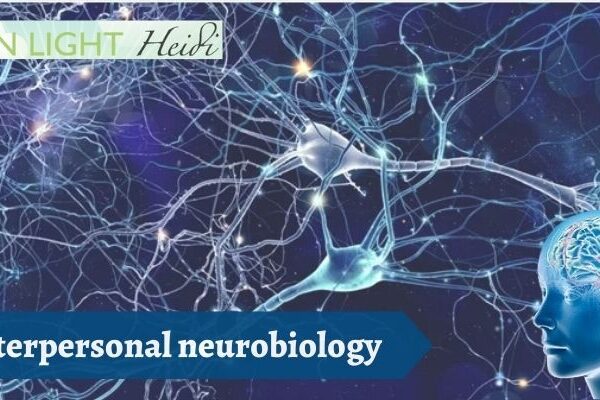
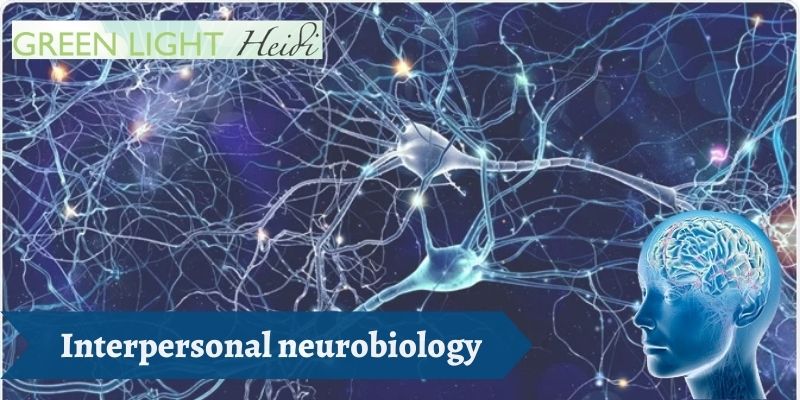
In interpersonal neurobiology, anger as an emotion is viewed from the perspective of cognitive neuroscience. And cognitive neuroscience states that cognition and emotion are dynamically combined with physical arousal. When anger is induced as an emotion in humans, it can unconsciously affect physiological and neural resources.
Affective states of anger are subsequently expressed in the brain as well as the body, and these neural and physiological changes can influence the cognitive processes. Many studies and resources have been expended on studying the emotions of happiness, sadness, and fear, which align with psychopathological states of hypomania, depression, and anxiety.
However, anger is considered a secondary emotion that has remained understudied in physiology and neuroscience. Therefore, it gets particularly difficult to understand the effects of anger on behavior and cognition.
In this article, we shall discuss the aspects of interpersonal neurobiology and clinical practice that will help manage anger and its adverse effects on the human body.
What do we understand by anger?
Before we get ahead with the aspects of treating anger issues with interpersonal neuroscience, we must understand what exactly the emotion of anger denotes. Anger comes in from a point where an individual responds to a perceived threat. Anger could also be a reaction coming from the point of frustration.
In medical neuroscience, frustration is a trigger for eventual aggression and anger. This article aims to discover the cognitive neuroscience aspect of anger. According to years and years of research, experts have noticed that anger generally leads to aggression, which negatively impacts not only the individual but the entire society.
Anger can be managed with adequate use of techniques in interpersonal neurobiology. While anger is associated with emotions, violence or aggression is a behavioral pattern that arises from anger-related feelings. Anger needs to be managed at all costs, as a deficit of proper anger management could have negative consequences leading to ill mental health and poor decision-making abilities.
How can Anger be treated?
Anger and aggression can be treated using different methods. Psychotherapies based on cognitive behavior are one of the important aspects of interpersonal neurobiology and clinical practice, which have proven to be successful in calming down a person’s reactivity towards aggression and anger. Anger management has also helped increase the self-esteem of an individual.
However, mindfulness and cognitive behavior treatment are the best ways of managing anger, which are widely practiced today. Here are certain steps which will help you in controlling your anger:
1. Take a pause before you utter the words:
Generally, anger is expressed through spiteful words. In a heated interaction, it is easy to say some words you might regret later. Therefore, it is always the best idea to pause and breathe before you say anything that you wouldn’t really mean.
2. Instead of playing the blame game, express what bothers you:
Experts say it’s easy to blame the other person when the situation doesn’t work in your favor. However, it would be a wiser choice to express the details or incidents that bother you instead of shifting the blame onto someone else. You always have a choice to express your frustration without confronting an individual, so you do not end up hurting someone unintentionally.
3. Exercising helps:
The experts in interpersonal neurobiology suggest exercising as one of the best solutions for anger management. When you are involved in some forms of physical activities, serotonin is released in your body. And the serotonin hormone is known for reducing stress and frustration. So once your frustration is taken care of, there will hardly be any point that would trigger you.
4. Taking small breaks are important:
Plan your schedule in such a way that you will be able to take some small breaks in between a stressful situations. More than small children, adults need to be introduced to the concept of taking some breaks in between. A few moments of solitude or a break from work will help you clear your mind and release some frustrations.
5. Let go of the things that hurt you:
We understand that letting go of the things that hurt you is not an easy task. And it is always easier to preach than practice. When you let negative emotions and anger consume you, you will ultimately be more affected by the situation than the other individual or incident that caused you pain. Forgiving is difficult, but it is the best solution in order to strengthen yourself and help you learn from a specific situation.
6. Look for solutions instead of causes:
There will always be endless possibilities and incidents that might be the reason behind your hurtful feelings. But, now that the moment is gone and if you cannot do anything to change what happened, it is better to look for solutions to resolve it rather than digging a grave of problems and causes.
As they always say, let the bones be buried in the closet. If you consult with a therapist with interpersonal neurobiology and clinical practice, they will help you focus on finding solutions to resolve the problems rather than holding onto them.
Conclusion:
Several steps are there to help you manage your anger issues. However, suppose you feel your anger is turning into aggression and repeatedly harming you and others around you. In that case, it’s better to seek professional help from an interpersonal neurobiology expert. They will help you find out the root cause of your distress, and with adequate counseling sessions, your stress and frustration can be resolved.
If you are looking for an expert in psychoanalysis and interpersonal neuroscience therapy, we at Green Light Heidi can help you. Dedicated professionals at our clinic look into the aspects that bother you using a scientific approach and proven techniques. To book a session with us, drop an email at [email protected]
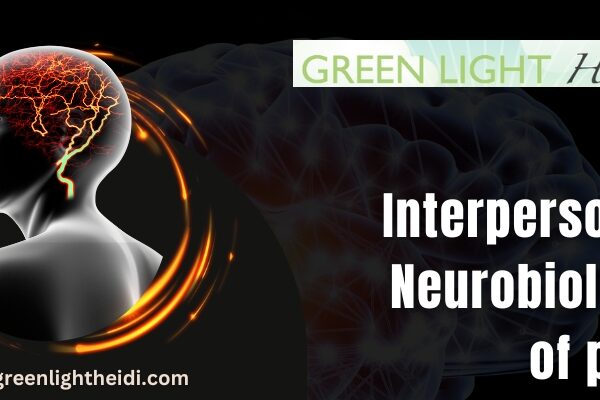
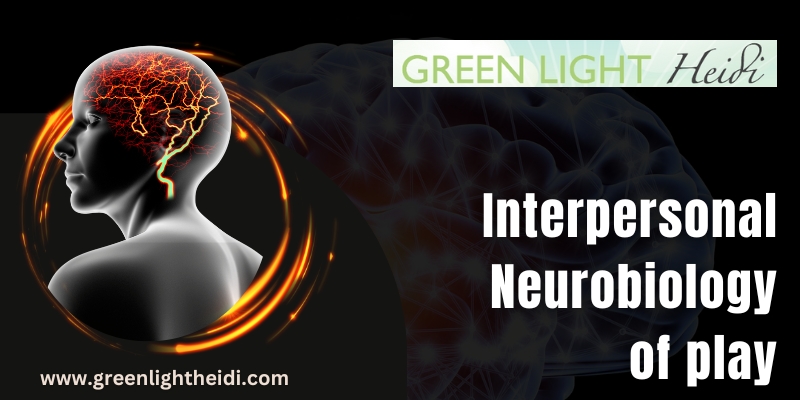
Play therapy is an effective technique to help children open-up and heal from trauma. It can help them in treating mental illness and emotional issues. Children find it easier to express themselves with games and play. Instead of using the conventional method, play method is used to help kids who have difficulties expressing themselves.
The interpersonal neurobiology of play is based on the play therapy. Interpersonal neurobiology brings together multiple fields together to determine how human minds work. And, by working on various aspects, healing can be done more effectively. Different fields include but not limited to biology, linguistic, psychology and more.
Find out how play therapy works and why it matters when it comes to healing.
What is Play Therapy?
Play therapy is a psychotherapy technique that relies in play and games to help kids express themselves. This method can help them express themselves more effective and heal from emotional and mental issues.
In this method, a therapist will guide a person to express themselves in a free and secure environment. First, they are made to feel comfortable so that they can feel free and safe. Then, activities like board games, puzzles and painting are used to help kids be more expressive. At the same time, other family members are also encouraged to get involved. This way, a child can feel more comfortable and learn to trust.
A wide range of activities are used in play therapy session. Some of the most popular ones are:
- Art and painting
- Board games, puzzles and more
- Building blocks and LEGOs
- Sand play
- Playing with dolls
- Tea party
- Card games, chess and other board games
When It can Be used?
Play therapy can work for a wide range of situations. It is mostly used to help kids become more expressive. Children can suffer from emotional and mental illness for a variety of reasons, such as abuse or trauma. This technique is helpful in so many ways and can be used to help kids overcome their issues.
Here are some examples of how play therapy can help:
- Autism is a type of behavior or communication disorder and pay therapy can help kids improve
- ADD and ADHD can also use play therapy to help kids overcome some of the symptoms and improve communication.
- Depression and anxiety can also affect kids. Play therapy can work in case of kids. This technique can help them to express their feelings.
- PDST or Post-traumatic stress disorder – Play therapy can help with this condition too by encouraging kids to express more effectively.
- Children who have suffered from physical and emotional trauma can benefit from play therapy too. Interpersonal neurobiology of play is an effective strategy.
How Does Play Therapy work and Benefit Children?
Interpersonal neurobiology has many benefits, especially when it comes to helping kids. Play therapy is much more effective than regular therapy session. It gives kids a more convenient way to communicate. Kids who have hard time communicating, can benefit from this technique.
Here is how it works and benefits the children:
- Play therapy includes activities or play to help kids communicate. For instance, they can use painting or drawing or even written text to communicate. This is an effective technique to help kids open-up.
- Kids can also use toys and other playing tools to express their feelings. For instance, they can express through toys they most relate to. In many ways, playing things can help kids become more expressive.
- Instead of making them sit on a chair or sofa and have conversation, therapist can use playing to extract information. While playing, kids can voluntarily give information. Plus, playing environment can make them feel more comfortable and at home.
- Some kids are shy, but some can be aggressive too. In both cases, the play therapy can help them in changing their behavior, or understand where aggressive behavior is coming from. Playing activities can help unearth the real reasons.
Interpersonal Neurobiology of Play
Play therapy is an effective technique that can be used with interpersonal neurobiology method. Play therapy can be helpful for both children and adult. It can help them regulate their feelings and understand their painful experience better to heal. Interpersonal neurobiology involves multiple aspects of science for treatment and healing of people who have suffered some kind of trauma. In this regard, the play therapy or interpersonal neurobiology of play can be an effective way to address the issues.
The Bottom Line
Interpersonal Neurobiology of Play or play therapy can be helpful in many ways. It can help kids heal and improve their condition. It can help kids who have difficulty communicating or have suffered trauma and other condition. Play therapy is a fun and relaxed way to help kids overcome their condition. In many ways, it is an effective to dela with such condition. Green Light Heidi offers lessons on interpersonal neurobiology and helps understand how this technique works. You can order the video online. Learn the power of brain and how neurobiology can help change the way you perceive things. Find out more about this technique and how it can help you, here – https://greenlightheidi.com/media/
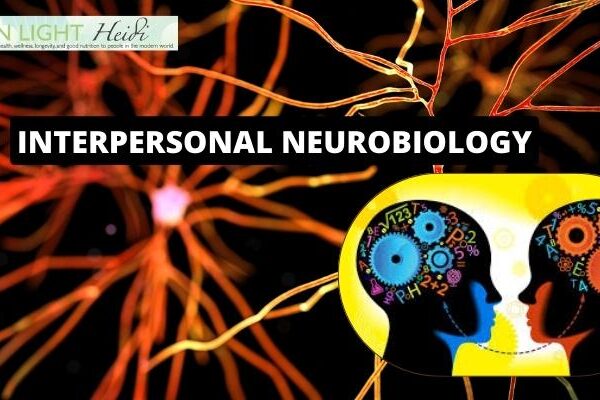

IPNB or Interpersonal Neurobiology is the brainchild of Allan Schore and Dan Siegel. The concept of IPNB is based on the foundation of continuous growth of the brain. The technique of IPNB is used to stimulate the brain with positive and powerful persuasion to heal trauma. According to a recently published book called interpersonal neurobiology of play, this conceptcan help transform conditions which were once known to be permanent.
Essentially the concept of Interpersonal Neurobiology is an interdisciplinary area that involves several fields of science, including –biology, anthropology, mathematics, linguistics, psychology, and physics, to know more about human experiences from various angles. This article will cover A to Z of interpersonal neurobiological science and its applications for human beings. Read on to know the details.
The Concept of Interpersonal Neurobiology:
The effects of therapy on the human brain are explored through the applications of interpersonal neurobiology. The doctors can also understand the mechanism of the brain and the impact that life experiences have on our minds. Before the discovery of IPNB, experts claimed that neurological growth stops at the onset of adulthood.
However, as developed in some of the latest studies, Neuroplasticity claims that neurological links and the neurons keep on forming and evolving throughout a person’s life. This newer concept of brain development entirely backs the theories of interpersonal neurobiology and offers confirmation of its efficacy and validity.
A clearer understanding of how neurological links function and how they affect the human mind, spirit, and body will help the clinicians determine to rebuild and reconnect the links to create a healthier internal environment.
Applications of Interpersonal Neurobiology:
1. Neural Pathways using Meditation for Healing:
According to the tests conducted by medical science and clinical studies, meditation has proven to have healing powers on the physical as well as the emotional body of the human being while creating a sense of awareness and generating neural pathways. Through meditation, one can automatically shut their mind off and explore what is happening on the insides of their body. Also, Interpersonal Neurobiology is drawing from several fields to cure trauma, and the highest role here is played by mindfulness or meditation.
With continuous meditation and interpersonal neurobiology, a person becomes enlightened to ideas, behaviours, and thoughts that seemed hidden under layers. Several discoveries can be instilled in people’s minds through appropriate techniques and trigger their inner wisdom. For more information regarding the same, you can go through a book named “Interpersonal neurobiology of play.”
According to the theories of IPNB, the generation of these new patterns in the brains of an individual can affect the emotional, psychological, and physical aspects of human beings irrespective of their age. Also, with the advent of every new kind of behaviour, attitude, piece of knowledge or idea, a person’s brain is being physically influenced and reconstructed. And this helps the doctors in interfering with the minds of their patients to heal them emotionally.
2. Interpersonal Neurobiology healing trauma survivors:
All the psychotherapists and psychiatrists benefit extremely from the applications of interpersonal neurobiology in treating patients with PTSD (Post Traumatic Stress Disorder). As stated above, brain cells and neurological links can be constantly transformed throughout an individual’s life. A similar sense of persuasive science is being used to influence the minds of traumatized patients.
Using interpersonal neurobiology, scientists are exploring how the human mind grows and changes based on different relationships. When a person is in a positive relationship, it begets positive transformations in one’s mind that results in healing from the previously experienced trauma.
3. Integration of Interpersonal Neurobiology in the field of Finance:
The field of Finance requires a conceptual framework for the planners to enhance their clientele relationships, calm down their clients’ fears, and have a closer insight into their emotions, which will further lead them to make certain financial decisions while inculcating the well-being of their clients. In such a scenario, interpersonal neurobiology comes to aid the financial planners.
The process of INPB can help integrate psychological, physiological, cognitive, and emotional functioning, which can be effectively applied to the relationship of financial planners and facilitate the incorporation of behavioural changes.
Financial experts with the application of interpersonal neurobiology can understand their clients’ attitudes, know their decisions and motivations, and have an insight into their beliefs and financial behaviours. According to the latest studies, a financial planner must have high emotional intelligence and a clearer understanding of the human element.
These requirements in the finance field have given rise to a more holistic approach to enhancing a client’s experience, creating consistency in the clients’ values and beliefs, and catering to their behaviour. The retention of a client will solely depend on the financial planner’s capability to enhance their self-consciousness and foster deep interpersonal relationships.
Conclusion:
Initially, science rejected the notion of relationships changing the brain’s neurological and structural aspects. However, this view, now known as interpersonal neurobiology, is being deeply accepted and applied in various fields to benefit humankind. The concept of IPNB can be used in validating and deepening the therapeutic interventions and conceptualizations.
Green Light Heidi is here to assist you throughout the process if you wish to embark on your journey with interpersonal neurobiology. Our focus is on the regulation of the nervous system through altering unique issues faced by our clients. Our platform will assist you in altering your brain’s condition by bringing in changes in your mind. For further queries or to secure an appointment, reach out to us via mail at [email protected]

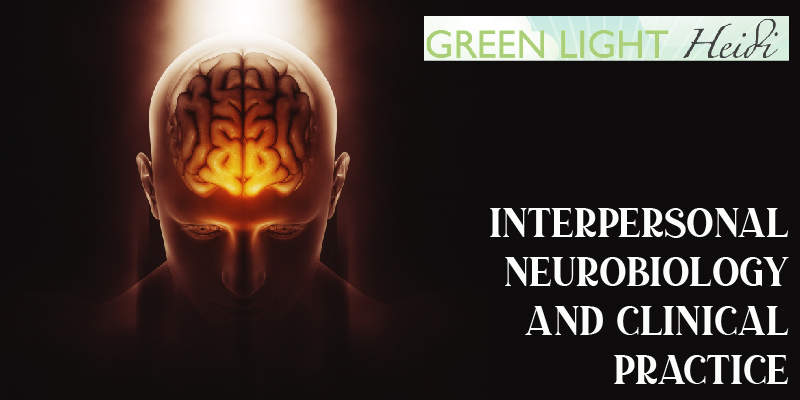
If ever there was a way to understand how our brain’s physical features & chemical interactions with the surrounding environment and emotions wouldn’t you want to learn more about it? Whether you wish to be trained in a rather chemical/biological direction or more of a sociological/psychological direction, there is an interdisciplinary aspect that can help you work out the human relationships and interactions. This aspect is known as interpersonal neurobiology and clinical practice.
But, what is it? Let us learn more about the importance of interpersonal neurobiology and its applications.
Interpersonal Neurobiology: What Is It?
Simply put, interpersonal neurobiology is an interdisciplinary aspect that describes the ways our body and brain are developed & function in context with relationships throughout our life. These interconnected pieces of scientific study tend to be critical for ensuring that learning is effective while resolving any trauma or conflict.
Interpersonal neurobiology is also critical to growing your personal relationships. Understanding the science behind what we understand about human interactions provides us with a reliable base for understanding one another while improving existing poor relationships. So, make sure you check out this pocket guide to interpersonal neurobiology.
Why is interpersonal neurobiology important?
Counselors, therapists, & clergy members from different work fields wish to have explanations and languages that help them understand their clients better. It helps decode what happens to them along with the coping strategies that help them get better, procure a healthy relationship, & aid healing from trauma.
This study also offers additional insights into decoding why several relationships face mental struggles and challenges. Healthcare workers and teachers tend to spend a good amount of time educating individuals. However, they don’t always know about the best ways to reach out to their patients or students that help get the desired results. Understanding the best ways in which the aspect of learning is embedded into our brain can help spark fresh strategies that are helpful in connecting with people while ensuring learning is successful.
When you learn interpersonal neurobiology and clinical practice, it opens up multiple pathways to growth and healing. With interpersonal neurobiology in practice, the paths become channelized and clearer, especially in patients that deal with mental health issues.
What does interpersonal neurobiology involve?
Interpersonal neurobiology seeks similar patterns arising from different knowledge banks and subjects to be implemented in interpersonal development. This approach is designed to invite different scientific branches in a way that helps them come together to find common principles that help understand the human experience. A pocket guide to interpersonal neurobiology involves a framework with the following subjects introduced as a contributor:
- Cognitive science
- Anthropology
- Computer science
- Biology (evolution, developmental, zoology, genetics)
- Developmental psychopathology
- Mathematics
- Linguistics
- Mental health
- Neuroscience (cognitive, affective, social, developmental)
- Psychiatry
- Sociology
- Physics
- Psychology (developmental, experimental, cognitive, of religion, attachment theory, social, memory)
- Systems theory (complexity and chaos theory)
The concept of interpersonal neurobiology tends to weave research from the above areas of study into a well-strategized framework. This particular framework examines the findings among these independent disciplines. It provides the framework for interpersonal neurobiology. Generally speaking, interpersonal neurobiology and clinical practice help define one’s mind and the thought processes within while illuminating the components that are important for health.
Brain, body, and relationships
Just like any other mind-body-relationship model, interpersonal neurobiology and the clinical practice sees the body and brain intimately connected. When talking about neural connections, there are several brains within our body that are connected to one core piece. Talking about the numbers, the human gut carries about 100,000,000 neurons which are also known as gut-brain.
These neurons are connected with several other neural networks & ultimately, the prime brain is located inside the skull. The study of interpersonal neurobiology involves understanding the connectivity between:
- Hippocampus
- Brainstem
- Prefrontal cortex
- Amygdala
Together, these parts within the brain help control 9 core interpersonal and neurobiological functions that include aspects such as:
- Fear modulation
- Body regulation
- Response flexibility
- Attuned communication
- Empathy
- Emotional balance
- Intuition
- Moral awareness
- Insight
In interpersonal neurobiology and clinical practice, our relational and embodied processes are regulated by the energy flow & information within & between brains. This triangle of our existence can be broken down into different facets of our mind that include aspects such as:
- Subjective experience:
It is one’s individual perception & their life’s felt texture.
- Information processing:
Our mind tends to process the energy patterns the very same way our computer stores, collects, uses, & produces information symbolizing cascading of entities used for accessing information & similar mental activities.
- Consciousness:
It is the experience that helps one become aware or help know about the knowledge surrounding us.
- Self-Organization:
The concept of self-organization symbolizes a complex yet organized system that differentiates & then links the regulation of energy and information flow of your own emergence. Lack of self-organization can cause a rigid or chaotic unfolding of several events in one’s life. In interpersonal neurobiology and clinical practice, one encounters circumstances that help individuals understand the rigid/chaotic cycles.
Conclusion
The implementation of interpersonal neurobiology aids in the therapeutic improvement of individuals in need of both professional and personal development. When you go through the step-by-step pocket guide to interpersonal neurobiology, you get access to enhanced empathy, compassion, & acceptance towards others as well as self. Thus, there is an increasing need for interpersonal relationships between practitioners & clients.
Are you looking for dedicated professionals that get you access to longevity, wellness, health, & good nutrition? Head over to Green Light Heidi and connect with me to attain the benefits of interpersonal neurobiology. We help you with everything from fear modulation to empathy development as you connect to your inner self. If you wish to connect with me, shoot a mail at [email protected]
